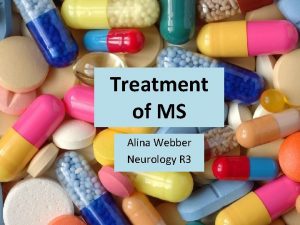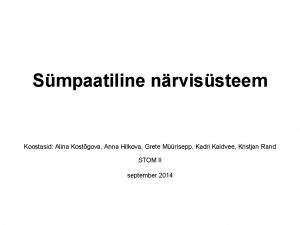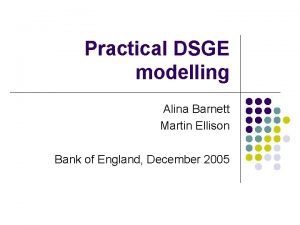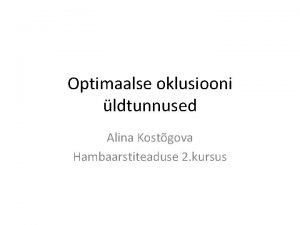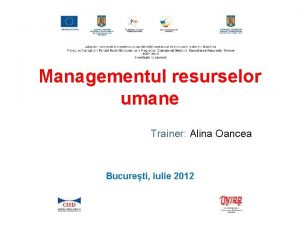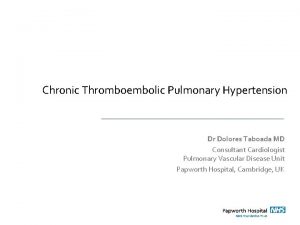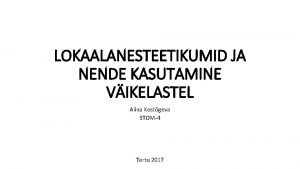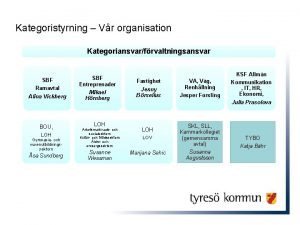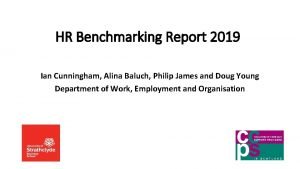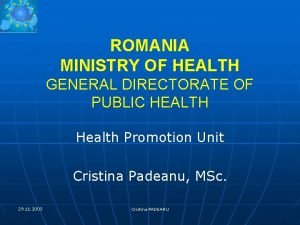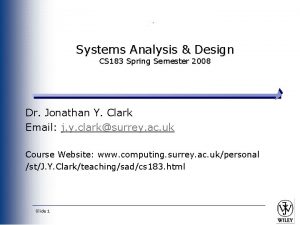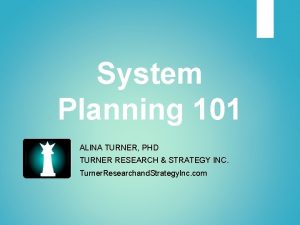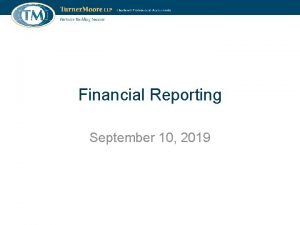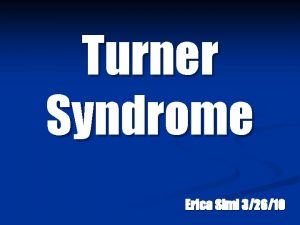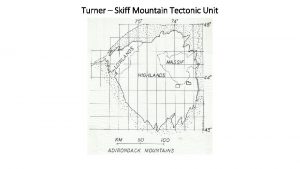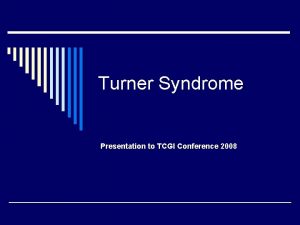SYSTEM MAPPING 101 Dr Alina Turner David French





































- Slides: 37

SYSTEM MAPPING 101 Dr. Alina Turner David French Jennifer Tipple Marty Thompsen October 23 rd, 2018

SYSTEMS MAPPING 101 Dr. Alina Turner, Turner Strategies October 23, 2018

WHAT IS IT? Essential first step in any effort to apply a systems planning approach to complex social issues, like homelessness. It involves methodically finding, categorizing, and analyzing social assets/resources operating in your community.

Systems Mapping 101 4 October 23, 2018 WHAT DOES IT INVOLVE? Must-have now vs. must-have later. 1. Up-to-date resource directory for all services available for those at risk/homeless in community. 2. Categorization of all programs by target population, geographical scope, service focus. 3. Mapping of locations to discern location patterns. 4. Real-time occupancy report to show what spaces are available in services. 5. Clear eligibility criteria, access/referral process for those looking for help. 6. Feedback loop from clients/users of services to each of the resources. 7. Performance indicators to track community demand feedback on services.

Systems Mapping 101 5 October 23, 2018 WHAT DO YOU NEED TO CAPTURE? Starting with the homeless-serving system, then beyond. • • Basic Info: Name, Address, Contact Info Program/Housing Type Capacity (Units/ Beds/ Caseload) % Occupancy/ Fill Rate (Currently or Average) • Length of Stay (Average) • Target populations (DV/ families/ youth/ Indigenous/refugees, etc. ) • Eligibility & Prioritization Criteria • • • Participation in Coordinated Intake (y/n) Acuity Assessment Tool Use Target Level of Client Acuity (Low/ Med/ High) % Capacity Accessible to Chronic/ Episodic % Capacity-Low Barrier (active substance use) % Capacity-High Barrier (sobriety required) % Return to Homeless-ness w/in 1 yr % Exits to Permanent Housing Estimated Annual Funding per program

Systems. Capacity Mapping%101 Program/ Housing (Units/ Occupancy Type Beds/ / Fill Rate Caseload (Currently ) or Average) Emergency Shelter Transitional Housing Affordable Housing Permanent Supportive Housing Rent Supplements Outreach Rapid Rehousing Intensive Case Management Assertive Community Outreach Other Support Services (List) # Vacant Permanen t Housing Units Currently Length of Stay (Average) Target populations (DV/families/ Youth/ Aboriginal) Eligibilit y Criteria Prioritization Criteria 6 Participation in Coordinated Intake (y/n) Acuity Assess ment Tool Use Target Level of Client Acuity (Low/ Med/ High) % Capacity Accessible to Chronic/ Episodic % Capacity. Low Barrier (active substance use) % Capacity. High Barrier (sobriety required) 23, % Return to. October % Exits to Homeless. Permanen ness w/in 1 yr t Housing 2018 Estimate d Annual Funding

7 Systems Mapping 101 WHY DOES THIS MATTER? 7 October 23, 2018 Health Justice Poverty Reduction The homeless-serving system is only a part of the social safety net ecosystem. Homeless-Serving System Children’s Services Housing Social Services Education

8 8 Systems Mapping 101 October 23, 2018 FOR INSTANCE In Calgary, Housing First programs make up <0. 5% of the services available to those at risk/experiencing homelessness and their $1 billion annual budget. 10, 000 WITHOUT private or informal services. 5, 500 57 Housing First Services 211 Calgary Service Listings Current Calgary System Map

9 9 Systems Mapping 101 October 23, 2018 MAKING COORDINATED ACCESS WORK The By-Names-List (BNL) tells you what you need. You need to match people to resources based on needs. Your real-time System Map tells you what you have available. It also allows you to leverage what your entire community has, not just what you fund/operate.

Systems Mapping 101 10 October 23, 2018 STEP-BY-STEP 1. Find all the resource lists in your community, cross-reference, categorize. Don’t forget your public systems (health), informal services (churches) and private sector (counsellors). 2. Engage the players to update their info, list their programs & services in a common database. Ideally, you’d make sure this is available publicly so your system becomes transparent to people in need. 3. Work to develop a real-time occupancy report and integrate this into your Coordinated Access process. 4. Introduce client feedback mechanisms across the ecosystem; use the data to gauge impact, trends, and strategy development/adjustment in real-time. Get excited about Big Data!

LETHBRIDGE ASSET MAPPING PROJECT (LAMP) Marty Thomsen, Community Social Development, City of Lethbridge October 23, 2018

We all hold an oar to the dragon boat.

Systems Mapping 101 13 October 23, 2018 LETHBRIDGE CONTEXT Growing community with new/changing pressure points Strategic response needed to tie diverse sectors into coordinated approach Coordination of assets remains a challenge Better leveraging & coordination of resources for those in need

OUR APPROACH 1. Analysis of a newly developed asset map and related database (Help. Seeker) 2. Social network analysis of organizations providing social supports and services in Lethbridge (Network Survey) 3. Extensive, cross-sectoral engagement & consultation (business, public, non-profit, government, lived exp. ) 4. Research & best practice analysis (local/national/international - academic/grey)

Systems Mapping 101 15 MAPPING OUR SYSTEM Estimate 1, 000 services in community of 100, 000 We have 250 mapped out w/ data coming in Significant engagement to date October 23, 2018

Systems Mapping 101 AT A GLANCE 16 October 23, 2018

A LIVE PUBLICALLY AVAILABLE MAP OF COMMUNITY RESOURCES

MAKING SENSE OF HUNDREDS OF SERVICES

REAL-TIME ANALYTICS TO TRACK SERVICE DEMAND BY POPULATION, SERVICE FOCUS

COMPARING TRENDS ACROSS REGIONS, PROGRAMS, SERVICE CATEGORIES & CLIENT FEEDBACK

TAKING IT TO THE NEXT LEVEL: REAL-TIME SYSTEM OCCUPANCY

SYSTEMS MAPPING IN ST. JOHN’S, NL Jennifer Tipple, Performance Management Planner End Homelessness St. John’s October 23, 2018

Systems Mapping 101 23 CURRENT SYSTEMS MAP • • Hosted by Thrive CYN Static website listing + 251 -page PDF Updated annually 6 categories • Housing • Recreation • Employment • Justice • Learning • Health October 23, 2018

Systems Mapping 101 24 UPCOMING SYSTEMS MAP • • • Integrated into EHSJ website front page Interactive map-based listing Updated as required 3 major categories 46 filters, ranging from case management to showers Integration with Help. Seeker October 23, 2018

25 Systems Mapping 101 SYSTEMS MAP COMPONENTS Must-have now vs. must-have later. Phase II 1. Up-to-date resource directory 2. Categorization of all programs 3. Mapping of locations 4. Real-time occupancy report 5. Clear eligibility criteria 6. Feedback loop 7. Performance indicators October 23, 2018

Systems Mapping 101 26 October 23, 2018 GETTING TO PHASE I Must-have now vs. must-have later. You will need: Phase I 1. Up-to-date resource directory • Dedicated staff capacity 2. Categorization of all programs • Attention to detail • Compatibility with other initiatives 3. Mapping of locations 4. Real-time occupancy report • i. e. Coordinated Access 5. Clear eligibility criteria • Weekly Systems Capacity Report

Systems Mapping 101 27 October 23, 2018 GETTING TO PHASE II Phase II You will need: 1. Up-to-date resource directory • Feedback from clients, staff, etc. 2. Categorization of all programs • Info on program evolution 3. Mapping of locations • HF fidelity 4. Real-time occupancy report • Acuity mix, funding, etc. 5. Clear eligibility criteria • Ongoing data collection 6. Feedback loop • % occupancy 7. Performance indicators • Delivery on outcomes (i. e. housing stability)

Systems Mapping 101 28 October 23, 2018 INTEGRATING WITH COORDINATED ACCESS • By Name List (BNL) • Systems Capacity Report Overarching principles: • • Collaboration • • Currently updated weekly Collective Impact Working Group • Transparency • • Accountability For cases requiring a collaborative response Systems Coordination Table • Efficiency of resources • • Focus on participant needs High-level systems table to identify and fill gaps in system responses

THANKS FOR LISTENING! For more info: jtipple@stjohns. ca 709. 685. 4068

SYSTEMS MAPPING 101 David French, Director of Policy and Planning A Way Home Canada October 23, 2018

System Planning impacts: • Think beyond “just” the homeless sector • Community nimbleness can inform broade planning • Capturing lived experience is foundational

Inform broader planning: • Community lead solutions can become comprehensive policy responses. • Track your progre (palatably), so insights and learn

Bring Lethbridge Home Centralized Access A Plan for Alberta: Ending Homelessne

Want to streamline system planning? Work to align demographic data (ie. youth age, ethnicity); Facilitate opportunities to share that data across programs; Delineate between risk of homelessness / risk of prolonged homelessness; and Adopt a collective impact

overnments must be: Prioritizing and supporting systems integration in all efforts to proactively address those at-risk of homelessness or experiencing homelessness. As part of this systems integration, all provincial/territorial ministries and departments should be mandated to identify their roles and responsibilities in homelessness.

Governments must be: ngaged in the ongoing eview of current system arriers to assess how he prevention of omelessness can be mproved across ystems, including hrough integration and mproved access to ervices, supports, and

QUESTIONS?
 Dr. alina turner
Dr. alina turner The associative mapping is costlier than direct mapping.
The associative mapping is costlier than direct mapping. Forward mapping vs backward mapping
Forward mapping vs backward mapping Terjemahan
Terjemahan Alina webber
Alina webber Alina kostõgova
Alina kostõgova Grete stern
Grete stern Alina orlova dog
Alina orlova dog Alina luca
Alina luca Centkiewiczowie prezentacja
Centkiewiczowie prezentacja Enoftalm
Enoftalm Alina barnett
Alina barnett Alina kostõgova
Alina kostõgova Alina oancea
Alina oancea Alina rosa taboada
Alina rosa taboada 2fed alina
2fed alina Alina klose
Alina klose The story of teddy bears go back to 1902
The story of teddy bears go back to 1902 Alina kozarkiewicz
Alina kozarkiewicz Ana alina
Ana alina Dr alina tiraspolskaya
Dr alina tiraspolskaya Oracle of delpi
Oracle of delpi Nextalina
Nextalina Alina fokina
Alina fokina Alina kostõgova
Alina kostõgova Alina fokina
Alina fokina Kategoristyrning
Kategoristyrning Alina baluch
Alina baluch Alina orlova dog
Alina orlova dog Alina padeanu
Alina padeanu Priit eelmäe
Priit eelmäe Alina sbirlea
Alina sbirlea Alina wajda
Alina wajda Dr alina tiraspolskaya
Dr alina tiraspolskaya Alina baumann
Alina baumann Dr alina tiraspolskaya
Dr alina tiraspolskaya Dr. calin carmaciu
Dr. calin carmaciu Dr alina tiraspolskaya
Dr alina tiraspolskaya




